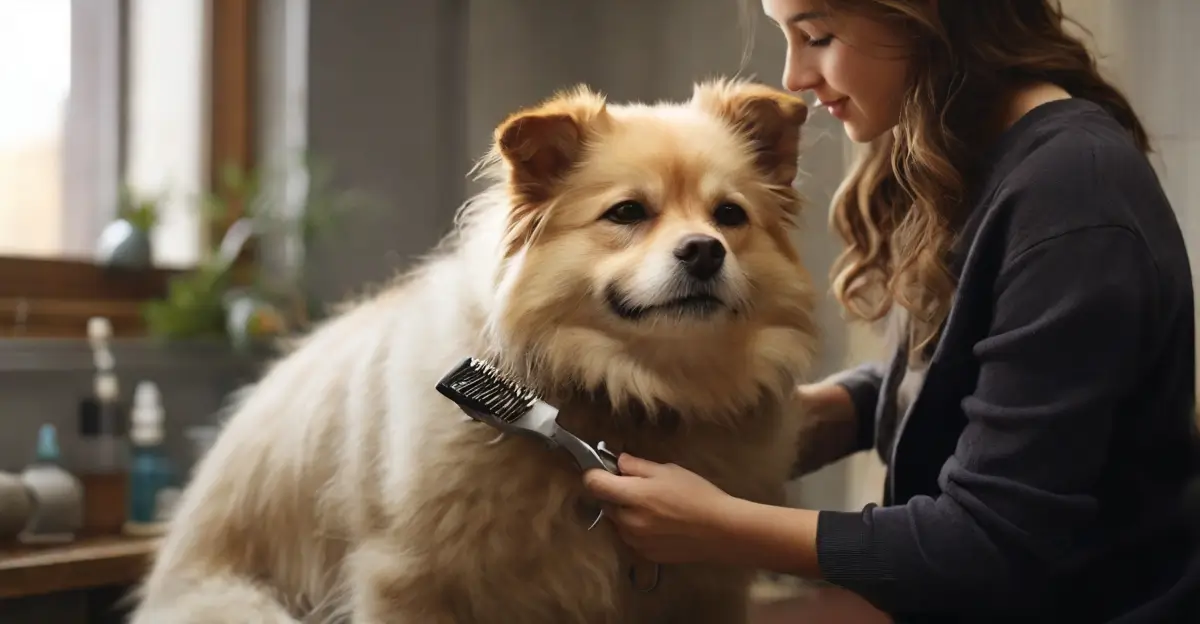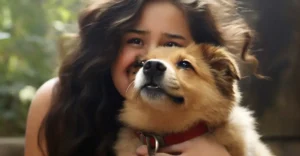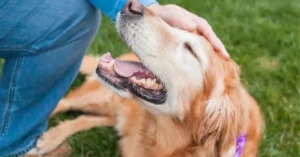Grooming a dog is very important for their health and happiness. However, it can be tough when they get scared or act mean around grooming tools. Understanding why many dogs attempt to bite anyone or have aggressive behaviors during grooming session is important. It might be due to fear or a negative experience in the past. Start by slowly letting your dog meet groomers and using ways to calm them down. This helps your dog feel better about grooming. Teaching your dog that grooming is okay, rewarding them with treats for sitting quietly, and showing them that the grooming equipment isn’t intended to hurt them rather makes grooming a fun time. When you learn what the groomers recommend keeping these tips, grooming becomes something you and your dog will enjoy. This makes grooming less stressful for your dog. This approach can turn every bath and grooming time into a safe and happy bonding experience.
Deciphering the Roots of Canine Aggression
Knowing why dogs might act mean whether you choose to groom is important for keeping everyone safe and happy. Slowly getting your dog used to being groomed and the tools used can help them relax and feel totally okay with it. Training your dog to tolerate grooming, coupled with patience and another treat for sitting patiently, reduces stress for any pet. This approach ensures grooming sessions become a positive activity for both you and your furry friend.
Recognizing the Telltale Signs of Aggression in Dogs
Seeing your dog growl or snap when needed to be groomed means they are not happy. It’s key to teach your dog to be less stressed during grooming to keep everyone safe. Giving them praise and treats can help them get used to and feel okay with grooming. If your dog still feels scared, letting them meet the groomer little by little can help make grooming easier for them.
Unraveling the Causes of Aggression in Canines
Understanding that aggression in dogs often stems from fear, lack of socialization, or negative past experiences is crucial for creating a safer grooming experience. Consult your vet for natural calming remedies, combined with gradual training like at-home grooming sessions, can significantly ease your dog’s anxiety. By reinforcing good behavior with praise and a reward, grooming can become a positive and safe activity for your furry friend and their groomer, fostering a sense of trust and security
Essential Skills for Grooming Aggressive Dogs with Care
Grooming a dog that gets upset easily can become a fun time for both of you with patience and the right training. By slowly getting your dog used tools and making sure they’re in a quiet place, you can help them not feel so worried or scared. Giving your dog treats for being calm during grooming can make them totally okay with it. This kind way of grooming makes it less scary for dogs, even those who might act out or try to bite at first, letting them relax and enjoy being taken care of.
The Power of Desensitization and Counterconditioning
One way to help is to slowly introduce your dog to grooming tools, giving them pup time to become familiar and sniff, see each one without making them scared. This, along with giving treats and kind words, can make the tools seem less scary. If your dog becomes less scared over time, they’re less likely to try to bite.
Selecting the Optimal Tools for Grooming Aggressive Dogs
Picking the right tools is also important. Quiet clippers and soft brushes are best because they don’t scare your dog or pull their fur. Remember, the aim is not to scare your dog but to help them feel okay with grooming. Choosing tools that fit your dog’s size and type of fur can help make grooming a time that is peaceful and not scary for your dog.
Crafting a Positive Grooming Session for Your Dog
Creating a positive grooming session when the dog involves more than just handling the grooming tools with care. It’s about building an environment and using techniques that help your dog feel safe, calm, and even happy during grooming. Let’s dive deeper into how you can use positive reinforcement techniques and create a serene ambiance to make grooming a pleasant experience for your aggressive dog.
Harnessing Positive Reinforcement Techniques
Using positive reinforcement is very important in making your dog okay with getting groomed regularly, helping them see that grooming tools are not scary. Giving your dog treats, kind words, or toys for being calm helps prevent them from acting aggressively, like trying to bite the groomer. This way of training your dog to be okay with grooming makes sure they start to like grooming sessions. If you keep doing this, grooming will become a time your dogs by doing the things that enjoys instead of feeling scared or upset.
Fostering a Serene Grooming Ambiance
Creating a calm grooming area with soft music and soothing scents can help your dog relax and prevent aggression. Having grooming tools ready beforehand keeps the session smooth. This setup makes grooming a bonding time for you and your pet.
Implementing Safety Protocols for Grooming Aggressive Dogs
When it comes to grooming and offer tips for an aggressive dog, safety is key. Not just for the pooch, but for the groomer too. This section will dive into how to make grooming sessions safer for everyone involved. We’ll talk about using muzzles and restraints correctly and when it might be a good idea to call in the pros for help. With the right approach, you can reduce stress for any pet and make grooming a smoother process.
Effective Use of Muzzles and Restraints
Introducing muzzles and restraints gently and allowing your dog to get used to them through sniffing, treats, and praise can reduce their fear and aggression. This careful method promotes safety and teaches your dog to view grooming tools as non-threatening. Gradually, this approach not only eases the grooming process but also shifts it to a positive experience, reinforcing the notion that grooming is beneficial rather than something to fear.
Seeking Assistance from Grooming Professionals
Getting help from our professional groomers is really important when your dog doesn’t like grooming and might get upset or scared. When you make an appointment with them, you’re making sure grooming is safe and less stress any pet. Our groomers can also teach you how to bathe and groom your dog at home, showing you the best tools and ways to do it. This help makes grooming easier and ensures you and your dog have a good time, just like the tips we’ve talked about here.
Step-by-Step Grooming Guide for Aggressive Dogs
Using kind training ways and helpful tips can make grooming better for dogs that usually get upset. Whether you choose to groom your dog yourself or make an appointment with experts, you can make sure it’s a calm and happy time for your pet. This method is really good for dogs that are scared of grooming. It turns grooming into a fun activity, no matter if you do it at home or with a professional’s help, making it safer for you and your dog.
Essential Brushing and Bathing Practices
Regular brushing with a soft brush helps prevent knots and keeps your dog’s fur smooth, making grooming a less daunting experience for anxious or aggravated pets. Using a brush suited for sensitive skin can turn grooming sessions into peaceful moments, teaching your dog to view them as caring rather than frightening. Gentle grooming, whether at home or with a professional, fosters a special bond between you and your dog.
Safe Nail Trimming and Ear Cleaning Methods
Introducing your dog to grooming with simple tasks like nail trimming and ear cleaning, coupled with treats and positive reinforcement, helps ease their fear. This approach teaches your dog to associate grooming with calmness and care, making the experience less intimidating. Gentle and patient grooming, whether done at home or by a professional, demonstrates to your dog that grooming is not only necessary but can also be a joyful time for both of you.
Advanced Techniques for a Smooth Grooming Experience
Grooming an easily distressed dog can be challenging, yet adopting specific strategies can simplify the process for both you and your pet. Discussing the use of calming medication with a veterinarian, alongside exploring natural methods to alleviate anxiety, are effective ways to create a stress-free grooming experience. Implementing these techniques thoughtfully ensures that grooming sessions become safe and enjoyable moments for our dogs, improving the experience for all involved.
Considerations for Sedation and Medication
If your dog gets really anxious or upset during grooming, talking to a vet about calming medicine can be a good idea. You have to be careful with this step. The vet can tell you the best and safest options and how to watch how your dog reacts to the medicine. The goal of using these medicines is to make grooming sessions less stressful for your dog, helping them feel better and making grooming easier for both your dog and the person grooming them.
Employing Anxiety-Reduction Strategies
To help your dog feel less worried during grooming without using medicine, you can try calming scent diffusers and make sure the grooming area is quiet and cozy. Teaching your dog to get used to bite anyone who approaches or tries to touch with special training exercises can also make them become familiar and comfortable during grooming. Using these natural ways and picking the right grooming space and tools can turn grooming into a happy time. This makes sure grooming is peaceful and fun for you and your dog.
Wrapping Up: A Journey Towards Stress-Free Grooming
Grooming goes beyond just appearances; it’s vital for our dogs’ health and strengthens our bond with them. By starting slowly, introducing grooming tools gently, and rewarding positive behavior, we can help our dogs become comfortable with grooming, especially those with past fears or traumas. Seeking appointment with our professional groomers can also enhance this experience, help make grooming sessions less stress-free and a bonding time, transforming challenges into opportunities for closeness.
FAQ: Grooming Your Dog
Q: Why do some dogs become aggressive when it comes to grooming?
A: Vets explain why some dogs become aggressive during grooming or fearful dog due to their bad past experiences. Understanding this helps us keep both the pooch and the groomer safe.
Q: How can I make my dog comfortable with grooming?
A: Start by letting your dog sniff the grooming area and the grooming equipment. This makes them less stressed. Tolerate regular grooming also helps your dog get used to the process.
Q: What should I do if my aggressive dog may bite during grooming?
A: If your dog bites or shows aggressive behavior, it’s important to address any aggressive behavior with training. Sometimes, many dogs exhibit aggressive behavior that may need special care to manage these types of dogs behaviors.
Q: Can aggressive dogs be groomed safely?
A: Yes, even aggressive dogs can be groomed. The key is to slowly get them used to grooming. Use tips to make grooming less stressful. This keeps everyone safe.
Q: How can I keep grooming sessions calm?
A: Giving the time depending on the want the dog is completely comfortable. Use calming techniques like treats and praise. This helps calm down during grooming sessions.
Q: What if my dog is impossible to groom?
A: No dog is impossible to groom. You may need to train your dog more or choose to have our professional. They can offer tips to help make grooming the session easier.
Q: When should I groom my dog?
A: Choose a time to bathe and groom when your dog is calm. This makes the session less stressful for both of you.



